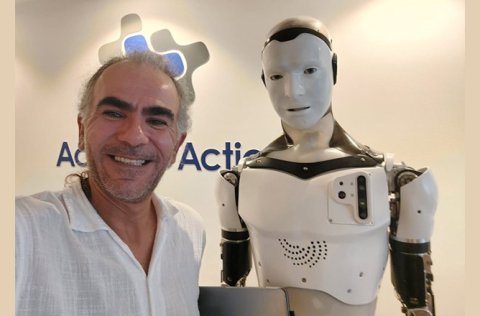CNME Editor Mark Forker secured an exclusive interview with Cizar Abughazaleh, Managing Director of Action-to-Action Robotics in an effort to better understand the mission statement of the company, the impact humanoid robotics is going to have on society, the AI infused within their suite of technologies – and why people should not be fearful of the humanoid robotics movement. 
A visionary, a pioneer, a technological evangelist, a reformer, those are just some of the superlatives that have been laid at the door of Cizar Abughazaleh.
In a remarkable career that has taken him from Singapore to New Zealand, Abughazaleh has firmly established himself as one of the most respected technology leaders in the Middle East since the turn of the new millennium.
In a storied career to date, Abughazaleh has worked for IT behemoths such as HP, Seagate, Dell Technologies EMC and Lenovo to name a few.
However, in 2014, the dynamic and charismatic technology innovator and entrepreneur decided to branch out on his own, and started Action-to-Action LTD.
Under the umbrella of that holding company is Action-to-Action Robotics.
At its core, Action-to-Action Robotics is an automation company that is designed to showcase and illustrate how humanoid robotics can be nurtured, leveraged and harnessed to transform businesses outcomes, processes and performance.
In a candid discussion with CNME, Abughazaleh kickstarted the conversation by highlighting the factors that led Abughazaleh to start Action-to-Action.
“My background was working with large technology players such as HP and Dell, but I could see that things were changing, and I could also see that there was this huge depth of young talent that were hungry to leverage technology to start revolutionising industries. Nowadays, there is a huge tech start-up ecosystem, but that was not the case 10 years. The combination of all these factors and the speed at which technology was developing led me to start Action-to-Action,” said Abughazaleh.
He stressed how he firmly believes that the adoption, integration and implementation of humanoid robotics can truly transform major industry verticals, and society as a whole.
“As I stated earlier, Action-to-Action Robotics was founded over a decade ago, out of a burning passion for innovation and technology. From the start, we envisioned how advancements in robotics and AI would transform people’s daily lives. Our goal has always been to address complex challenges through practical solutions, using robotics and AI, while also developing advanced applications to complement our offerings. As a technology company, our mission is clear and straightforward, and that is to solve complex problems practically and efficiently through the use of robotics and AI,” said Abughazaleh.
Abughazaleh then outlined how he was inspired to pivot his company towards robotics and humanoids after observing how Japan was leveraging robotics to help tackle the problem they faced with an ageing population.
“I was in Japan in 2012, and SoftBank at this point had not yet acquired Aldebaran Robotics, which was the robotics manufacturer that created Pepper, the semi-humanoid robot. I was intrigued to see how Japan was planning to use Pepper, and other semi-humanoid robots to help their senior citizens and ageing population. However, at that moment it clicked in my mind that this robotics movements was going to go much further, and that’s why I decided to position the company as a leader in robotics technology,” said Abughazaleh.
The conversation then shifted to how advancements in AI technology, such as LLM and NLP, has served to really accelerate the robotics movement on a global scale.
“There are a number of factors that has propelled the robotics space, but I certainly think it has become more accessible. If you look back to 10-15 years ago, the entry level in terms of cost for a humanoid would’ve cost you an arm and leg, however, with more and more players entering the game, it has made it more accessible and affordable,” said Abughazaleh.
Abughazaleh then went into more detail on the characteristics that ultimately define what humanoid robotics encompasses.
“Essentially, humanoid robotics involves robots that are designed to resemble and mimic human anatomy and behaviour, featuring bipedal locomotion, dexterous manipulation, and sensor integration for interacting with human environments. Key developments include reinforcement learning for improved locomotion, natural language processing for better human-robot communication, computer vision for enhanced perception, emotional AI for recognizing and responding to human emotions, and autonomous decision-making, all of which are pushing humanoid robots closer to real-world applications in various industries,” said Abughazaleh.
Action-to-Action Robotics has enjoyed huge success as a commercial entity, and under the enigmatic guidance of Abughazaleh appears to be going from strength-to-strength.
However, it’s fair to say that the robotics industry is an ultra-competitive landscape, but Abughazaleh cleverly articulated what makes his company stand out from the crowd.
“We ask ourselves the same question every year, and that is are we going to be there next year? You have to continually keep pushing boundaries. My view is we need to be always thinking about now, tomorrow and the next 10 years, that has to be the mindset in order to remain successful. However, ultimately what I think differentiates us is having the right team and right people in place. Technology is obviously key, but it is the people that make the difference, and thankfully for us, we have an incredible team in place that can drive the technology in the right direction to ensure the projects that we deliver are successful for our customers,” said Abughazaleh.
Abughazaleh also highlighted how their decade-long presence in the market had garnered a lot of trust in the company with both public and private sector entities across the Middle East region.
“As a pioneering entity in the Robotics and AI sector in the Middle East, we benefit from extensive visibility and influence in the region. With over a decade of experience deploying cutting-edge robotics solutions, our firm has built an exceptional reputation across public, private, and government sectors. Our notable projects span diverse areas, including healthcare, particularly hospitals, government and semi-government agencies, and educational institutions focused on research and development. Additionally, we have successfully delivered complex, customized solutions for transportation agencies, demonstrating our capability to address intricate and multifaceted challenges in various domains,” said Abughazaleh.
Action-to-Action Robotics have a broad and diverse portfolio when it comes to their suite of solutions and services, so rather inevitably they have the ability to serve a lot of key industries verticals.
However, as Abughazaleh explains, their solutions are better suited to what he described as the ‘caregiving industry’.
“One of the best segments for us when it comes to industry verticals is undoubtedly healthcare. We noticed when we started that nobody was going to say we want 10 robots in 10 hospitals, there was a barrier to market, which was determined fundamentally by cost and compliance. We launched the concept of robotics-as-a-service to make it more affordable for them to trial the technology, and enabled them to experiment with our robotics to see the impact it could have on their day-to-day operations. In summary, Humanoid robotics is most utilized in the healthcare and caregiving industry, where their human-like appearance and interaction capabilities are well-suited for tasks such as patient care, rehabilitation, and companionship. Their ability to communicate naturally, recognize emotions, and assist with physical tasks makes them ideal for supporting both patients and healthcare workers – and the whole movement was accelerated by the COVID-19 pandemic,” said Abughazaleh.
Abughazaleh also stressed that industries such as hospitality and education are also good fits for humanoid robotics.
“Beyond healthcare, humanoid robots have the potential to transform industries like customer service, hospitality, and education, where their human-like presence can enhance customer interactions, provide personalized services, and support learning environments, making them valuable assets in roles that require empathy, adaptability, and complex human interaction,” said Abughazaleh.
AI is everywhere, and following the advent of ChatGPT by OpenAI, the technology landscape is awash with Generative AI.
Enterprises across all verticals are now revisiting their AI investment strategies to see where they can harness the transformative capabilities of the technology.
However, Abughazaleh stressed the need for businesses to develop AI solutions that actually deliver outcomes for their customers, and he highlighted how their experience centre plays a unique role in helping to demonstrate how they use AI technologies.
“One of our most effective strategies is to demonstrate the capabilities of humanoid robots in action. At our Robotics Experience Centre in Dubai, our clients can engage directly with these robots, gaining hands-on experience and see first-hand what they can do. On the technology side, we integrate advanced machine learning algorithms that enable real-time learning and decision-making. By improving sensor fusion and data processing, our robots can better understand and react to dynamic environments. Additionally, AI-driven simulation and predictive modelling allow the robots to anticipate changes and adapt accordingly, enhancing their ability to perform complex tasks with greater precision and autonomy. However, it’s important to stress the need to businesses that you need to deliver results and outcomes, a shiny technology is nice, but does it solve a problem, and that is the question you need to ask yourself when setting out on your AI journey,” said Abughazaleh.
Capitalism by its very definition could be described as an economic system designed not for the many, but the few.
However, there’s no denying the benefit of capitalism and the free-market system, but collaboration and capitalism are something that certainly never came hand-in-hand.
That is starting to change, especially in the IT and technology domains, and in order to ensure success, more and more companies are collaborating together instead of going head-to-head, and Abughazaleh is a business leader who subscribes to the idea that collaboration is good for growth.
“To deliver robust solutions that effectively and cost-efficiently address practical challenges, it is essential to strategically collaborate with both local technology institutions and educational organizations, as well as establish partnerships on an international level. For instance, our technology and support MOU with Taiwan’s Institute for Information Industry (III) has provided us with valuable access to emerging technologies and tech start-ups, fostering mutual benefits for both parties. Another noteworthy example is our recent partnership between Action-to-Action Robotics and British University College. This collaboration aims to bridge the gap between academia and industry by offering students exceptional opportunities for hands-on experience, research collaboration, and professional development in the fields of Robotics and AI,” said Abughazaleh.
Despite the fact that AI is becoming more democratised and accessible to the mainstream, there still are some Orwellian fears over what impact humanoid robots will have on society.
Some are fearful of the fact that once the genie is out of the bottle it is hard to put back in, and despite the evident benefits of its introduction, the jury in some people’s minds are still out.
However, Abughazaleh concluded a wonderful conversation by reinforcing his view that humanoid robots will enhance our quality of life.
“While it’s natural to have concerns about humanoid robots, it’s important to recognize the significant positive impact they can have on society. These robots are designed to assist, not replace, humans in roles where support is most needed, such as in healthcare, where they can help care for the elderly, assist in rehabilitation, and provide companionship. They can take on dangerous tasks, reducing human risk in hazardous environments, and improve accessibility for individuals with disabilities. Rather than being Orwellian, humanoid robots are tools created to enhance our quality of life, empower us to focus on more creative and meaningful work, and address challenges that humans alone cannot solve efficiently. Embracing this technology with responsible development and ethical considerations can lead to a future where humanoid robots are trusted partners in improving human well-being,” said Abughazaleh.





